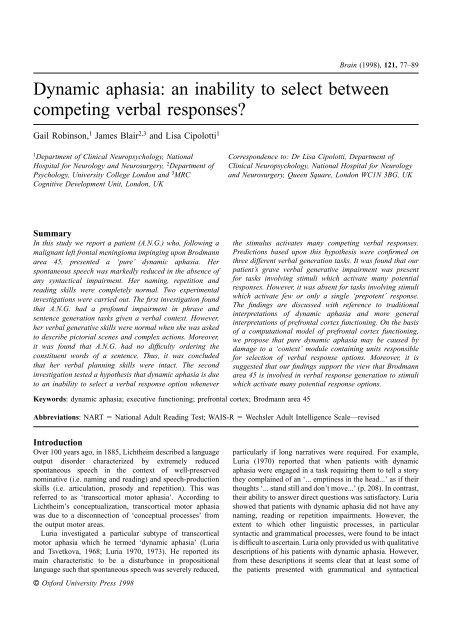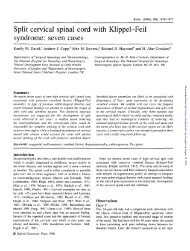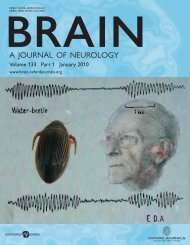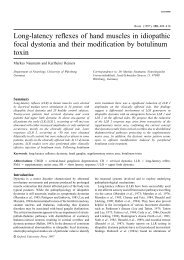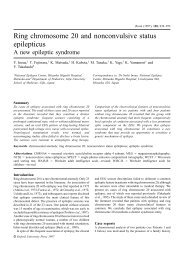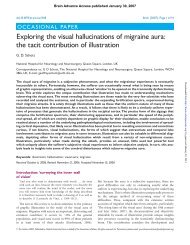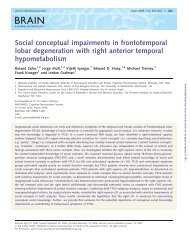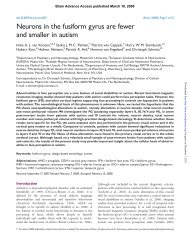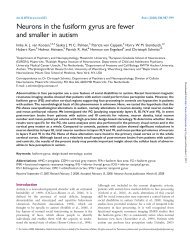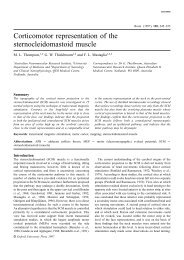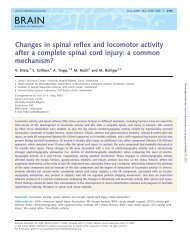Dynamic aphasia: an inability to select between competing ... - Brain
Dynamic aphasia: an inability to select between competing ... - Brain
Dynamic aphasia: an inability to select between competing ... - Brain
You also want an ePaper? Increase the reach of your titles
YUMPU automatically turns print PDFs into web optimized ePapers that Google loves.
<strong>Brain</strong> (1998), 121, 77–89<br />
<strong>Dynamic</strong> <strong>aphasia</strong>: <strong>an</strong> <strong>inability</strong> <strong>to</strong> <strong>select</strong> <strong>between</strong><br />
<strong>competing</strong> verbal responses?<br />
Gail Robinson, 1 James Blair 2,3 <strong>an</strong>d Lisa Cipolotti 1<br />
1 Department of Clinical Neuropsychology, National Correspondence <strong>to</strong>: Dr Lisa Cipolotti, Department of<br />
Hospital for Neurology <strong>an</strong>d Neurosurgery, 2 Department of Clinical Neuropsychology, National Hospital for Neurology<br />
Psychology, University College London <strong>an</strong>d 3 MRC <strong>an</strong>d Neurosurgery, Queen Square, London WC1N 3BG, UK<br />
Cognitive Development Unit, London, UK<br />
Summary<br />
In this study we report a patient (A.N.G.) who, following a<br />
malign<strong>an</strong>t left frontal meningioma impinging upon Brodm<strong>an</strong>n<br />
area 45, presented a ‘pure’ dynamic <strong>aphasia</strong>. Her<br />
spont<strong>an</strong>eous speech was markedly reduced in the absence of<br />
<strong>an</strong>y syntactical impairment. Her naming, repetition <strong>an</strong>d<br />
reading skills were completely normal. Two experimental<br />
investigations were carried out. The first investigation found<br />
that A.N.G. had a profound impairment in phrase <strong>an</strong>d<br />
sentence generation tasks given a verbal context. However,<br />
her verbal generative skills were normal when she was asked<br />
<strong>to</strong> describe pic<strong>to</strong>rial scenes <strong>an</strong>d complex actions. Moreover,<br />
it was found that A.N.G. had no difficulty ordering the<br />
constituent words of a sentence. Thus, it was concluded<br />
that her verbal pl<strong>an</strong>ning skills were intact. The second<br />
investigation tested a hypothesis that dynamic <strong>aphasia</strong> is due<br />
<strong>to</strong> <strong>an</strong> <strong>inability</strong> <strong>to</strong> <strong>select</strong> a verbal response option whenever<br />
Keywords: dynamic <strong>aphasia</strong>; executive functioning; prefrontal cortex; Brodm<strong>an</strong>n area 45<br />
Abbreviations: NART National Adult Reading Test; WAIS-R Wechsler Adult Intelligence Scale—revised<br />
Introduction<br />
Over 100 years ago, in 1885, Lichtheim described a l<strong>an</strong>guage<br />
output disorder characterized by extremely reduced<br />
spont<strong>an</strong>eous speech in the context of well-preserved<br />
nominative (i.e. naming <strong>an</strong>d reading) <strong>an</strong>d speech-production<br />
skills (i.e. articulation, prosody <strong>an</strong>d repetition). This was<br />
referred <strong>to</strong> as ‘tr<strong>an</strong>scortical mo<strong>to</strong>r <strong>aphasia</strong>’. According <strong>to</strong><br />
Lichtheim’s conceptualization, tr<strong>an</strong>scortical mo<strong>to</strong>r <strong>aphasia</strong><br />
was due <strong>to</strong> a disconnection of ‘conceptual processes’ from<br />
the output mo<strong>to</strong>r areas.<br />
Luria investigated a particular subtype of tr<strong>an</strong>scortical<br />
mo<strong>to</strong>r <strong>aphasia</strong> which he termed ‘dynamic <strong>aphasia</strong>’ (Luria<br />
<strong>an</strong>d Tsvetkova, 1968; Luria 1970, 1973). He reported its<br />
main characteristic <strong>to</strong> be a disturb<strong>an</strong>ce in propositional<br />
l<strong>an</strong>guage such that spont<strong>an</strong>eous speech was severely reduced,<br />
© Oxford University Press 1998<br />
the stimulus activates m<strong>an</strong>y <strong>competing</strong> verbal responses.<br />
Predictions based upon this hypothesis were confirmed on<br />
three different verbal generation tasks. It was found that our<br />
patient’s grave verbal generative impairment was present<br />
for tasks involving stimuli which activate m<strong>an</strong>y potential<br />
responses. However, it was absent for tasks involving stimuli<br />
which activate few or only a single ‘prepotent’ response.<br />
The findings are discussed with reference <strong>to</strong> traditional<br />
interpretations of dynamic <strong>aphasia</strong> <strong>an</strong>d more general<br />
interpretations of prefrontal cortex functioning. On the basis<br />
of a computational model of prefrontal cortex functioning,<br />
we propose that pure dynamic <strong>aphasia</strong> may be caused by<br />
damage <strong>to</strong> a ‘context’ module containing units responsible<br />
for <strong>select</strong>ion of verbal response options. Moreover, it is<br />
suggested that our findings support the view that Brodm<strong>an</strong>n<br />
area 45 is involved in verbal response generation <strong>to</strong> stimuli<br />
which activate m<strong>an</strong>y potential response options.<br />
particularly if long narratives were required. For example,<br />
Luria (1970) reported that when patients with dynamic<br />
<strong>aphasia</strong> were engaged in a task requiring them <strong>to</strong> tell a s<strong>to</strong>ry<br />
they complained of <strong>an</strong> ‘... emptiness in the head...’ as if their<br />
thoughts ‘... st<strong>an</strong>d still <strong>an</strong>d don’t move...’ (p. 208). In contrast,<br />
their ability <strong>to</strong> <strong>an</strong>swer direct questions was satisfac<strong>to</strong>ry. Luria<br />
showed that patients with dynamic <strong>aphasia</strong> did not have <strong>an</strong>y<br />
naming, reading or repetition impairments. However, the<br />
extent <strong>to</strong> which other linguistic processes, in particular<br />
syntactic <strong>an</strong>d grammatical processes, were found <strong>to</strong> be intact<br />
is difficult <strong>to</strong> ascertain. Luria only provided us with qualitative<br />
descriptions of his patients with dynamic <strong>aphasia</strong>. However,<br />
from these descriptions it seems clear that at least some of<br />
the patients presented with grammatical <strong>an</strong>d syntactical
78 G. Robinson et al.<br />
impairments. For example, he described case 8 who had<br />
suffered a penetrating injury in the inferior part of the<br />
premo<strong>to</strong>r area (Luria, 1970), who could still repeat single<br />
words <strong>an</strong>d name objects but had a noticeable disturb<strong>an</strong>ce in<br />
his spont<strong>an</strong>eous speech; he was unable <strong>to</strong> ‘... carry out <strong>an</strong>y<br />
kind of involved narration...’. In addition, he presented with<br />
a grammatical impairment; ‘... his speech was limited <strong>to</strong><br />
disconnected grammatically disordered word sequences...’<br />
(Luria, 1970, p. 207). Thus, it appears that some of Luria’s<br />
patients with dynamic <strong>aphasia</strong> presented with a propositional<br />
l<strong>an</strong>guage impairment complicated by grammatical <strong>an</strong>d<br />
syntactical difficulties. In contrast, others presented with a<br />
‘pure’ propositional l<strong>an</strong>guage impairment.<br />
Luria’s account of dynamic <strong>aphasia</strong> focuses on <strong>an</strong> <strong>inability</strong><br />
<strong>to</strong> form a ‘linear scheme of the sentence’. According <strong>to</strong><br />
Luria, propositional speech is initiated by a ‘pl<strong>an</strong>’. This is<br />
tr<strong>an</strong>slated through the tr<strong>an</strong>sitional stage of ‘internal speech’<br />
in<strong>to</strong> the linear scheme of the sentence. <strong>Dynamic</strong> <strong>aphasia</strong><br />
results from a breakdown in this tr<strong>an</strong>sitional stage. While<br />
the pl<strong>an</strong> is initiated, the breakdown in internal speech results<br />
in a failure <strong>to</strong> form the linear scheme <strong>an</strong>d thus, a disturb<strong>an</strong>ce<br />
of propositional speech.<br />
Costello <strong>an</strong>d Warring<strong>to</strong>n (1989) conducted a detailed<br />
investigation of a patient with dynamic <strong>aphasia</strong> (R.O.H.),<br />
who presented with intact naming, comprehension, repetition<br />
<strong>an</strong>d reading skills, but <strong>an</strong> almost complete lack of spont<strong>an</strong>eous<br />
speech. For example, when asked <strong>to</strong> describe his last holiday<br />
he produced only ‘I’m...’ in 30 s. One of the prominent<br />
features of his perform<strong>an</strong>ce was his poor verbal generative<br />
capability. In phrase <strong>an</strong>d sentence generation tasks he either<br />
failed <strong>to</strong> produce a response or his response latencies were<br />
extremely slow. However, the few responses that he did<br />
succeed in producing were normal in both form <strong>an</strong>d content.<br />
In particular, no morphological or syntactic errors were<br />
present. R.O.H. also showed a marked impairment in a<br />
sentence construction task where he was requested <strong>to</strong> order<br />
constituent words <strong>to</strong> form a me<strong>an</strong>ingful sentence. This poor<br />
perform<strong>an</strong>ce was in stark contrast <strong>to</strong> his preserved ability <strong>to</strong><br />
order constituent pictures <strong>to</strong> form a me<strong>an</strong>ingful s<strong>to</strong>ry in the<br />
Picture Arr<strong>an</strong>gement subtest of the WAIS. The authors argued<br />
that Luria’s conceptualization of dynamic <strong>aphasia</strong> could not<br />
account for R.O.H.’s perform<strong>an</strong>ce. They attributed R.O.H.’s<br />
difficulties <strong>to</strong> a <strong>select</strong>ive impairment of verbal pl<strong>an</strong>ning. They<br />
considered verbal pl<strong>an</strong>ning <strong>to</strong> be a ‘high order stage’ which<br />
is prior <strong>to</strong> the construction of a phrase <strong>an</strong>d/or sentence.<br />
Recently, there have been two further reports of patients<br />
who have been considered <strong>to</strong> present with dynamic <strong>aphasia</strong>.<br />
Esmonde et al. (1996) reported three patients with progressive<br />
supr<strong>an</strong>uclear palsy who showed reduced propositional speech<br />
in the context of preserved naming <strong>an</strong>d comprehension skills.<br />
In narrative <strong>an</strong>d picture description tasks these patients<br />
presented with reduced verbal output that was characterized<br />
by morphological <strong>an</strong>d syntactic deficits (unlike R.O.H.). Two<br />
of these patients were given sentence generation tasks <strong>an</strong>d<br />
their perform<strong>an</strong>ce was found (like R.O.H.’s) <strong>to</strong> be very<br />
poor. The authors concluded that their patients’ pattern of<br />
perform<strong>an</strong>ce most resembled Luria’s concept of dynamic<br />
<strong>aphasia</strong>.<br />
Snowden et al. (1996) reported a patient (K.C.) who had<br />
a progressive l<strong>an</strong>guage disorder associated with frontal lobe<br />
degeneration. This patient presented with a profound<br />
impairment of propositional l<strong>an</strong>guage despite well-preserved<br />
naming <strong>an</strong>d phonological skills. Similar <strong>to</strong> that of the patients<br />
described by Esmonde et al. (1996), K.C.’s profound disorder<br />
of propositional l<strong>an</strong>guage was not only characterized by a<br />
severe reduction in speech output but also by some mild<br />
syntactic difficulties. But K.C., unlike the previously reported<br />
patients, was unimpaired in phrase <strong>an</strong>d sentence generation<br />
tasks. K.C., like R.O.H., was impaired on a sentence<br />
construction task. However, her deficit was output modality<br />
specific. Unlike R.O.H., she could verbalize the sentence<br />
correctly even though she could not m<strong>an</strong>ually order the<br />
constituent words on the table. In addition, she presented<br />
grave difficulties in tasks requiring temporal integration. The<br />
authors concluded that K.C.’s impairment was in the temporal,<br />
sequential, aspects of propositional speech, which in m<strong>an</strong>y<br />
ways conforms <strong>to</strong> Luria’s concept of a stage that allows the<br />
tr<strong>an</strong>scoding of a pl<strong>an</strong> or intention in<strong>to</strong> the linear scheme of<br />
a sentence.<br />
The neuro-<strong>an</strong>a<strong>to</strong>mical correlates of the documented cases<br />
of dynamic <strong>aphasia</strong> cluster in the left frontal lobe. Luria<br />
thought the associated structures were in the lower part of<br />
the left frontal lobe just <strong>an</strong>terior <strong>to</strong> Broca’s area, with the<br />
premo<strong>to</strong>r cortex remaining intact. R.O.H. had a lesion in the<br />
left posterior-frontal region. Frontal lobe atrophy was noted<br />
in two of the three patients reported by Esmonde et al. (1996)<br />
<strong>an</strong>d a SPECT sc<strong>an</strong> indicated that K.C. had a reduction in the<br />
uptake of tracer in the frontal regions.<br />
In this paper, we report the case of a right-h<strong>an</strong>ded wom<strong>an</strong><br />
with a left malign<strong>an</strong>t fron<strong>to</strong>parietal parafalcine meningioma<br />
who presented with a ‘pure’ dynamic <strong>aphasia</strong>. Her<br />
spont<strong>an</strong>eous speech was markedly reduced while her<br />
syntactic, naming, reading <strong>an</strong>d repetition skills were<br />
completely normal. The purpose of this paper is <strong>to</strong> investigate<br />
the underlying mech<strong>an</strong>ism responsible for pure dynamic<br />
<strong>aphasia</strong>.<br />
Case report<br />
A.N.G. was a 59-year-old, right-h<strong>an</strong>ded, wom<strong>an</strong> who was a<br />
retired lecturer in genetics. In 1991 a malign<strong>an</strong>t left<br />
fron<strong>to</strong>parietal parafalcine meningioma was diagnosed <strong>an</strong>d<br />
subsequently excised. Recurrences of the tumour were excised<br />
in 1994 <strong>an</strong>d 1995 followed by radiotherapy. In September<br />
1996 a further partial removal of the parasagittal meningioma<br />
was undertaken at the National Hospital for Neurology <strong>an</strong>d<br />
Neurosurgery. At that time a meningioma was also present in<br />
the left frontal area. Pos<strong>to</strong>peratively she developed l<strong>an</strong>guage<br />
difficulties <strong>an</strong>d a right-sided weakness which improved with<br />
steroid therapy. A follow-up MRI sc<strong>an</strong> showed that her left<br />
frontal meningioma was impinging upon Brodm<strong>an</strong>n area 45<br />
(see Fig. 1). The patient died in February 1997.
Response <strong>select</strong>ion in dynamic <strong>aphasia</strong> 79<br />
Fig. 1 Gadolinium enh<strong>an</strong>ced T 1-weighted MRI in the horizontal (left) <strong>an</strong>d coronal (right) pl<strong>an</strong>es showing a meningioma in the inferior<br />
left frontal region.<br />
A.N.G. was referred <strong>to</strong> the Department of Neuropsychology<br />
for assessment of her cognitive functions. The present<br />
investigation was conducted over 1 week (Oc<strong>to</strong>ber 7–13,<br />
1996), with a follow-up investigation 2 weeks later.<br />
Table 1 Cognitive test scores<br />
Cognitive test Score<br />
Verbal IQ 83<br />
Perform<strong>an</strong>ce IQ 83<br />
NART IQ 124 ( 75 percentile)<br />
RMT words 31/50 (5 percentile)<br />
RMT faces 28/50 (5 percentile)<br />
Incomplete letters 19/20 (5% cut-off)<br />
Cube <strong>an</strong>alysis 8/10 (5% cut-off)<br />
Weigl colour form sort Pass<br />
Trail making B Fail<br />
Stroop Test Fail<br />
Cognitive estimates Fail<br />
Hayling sentence completion Fail<br />
New verbal switching test Fail<br />
NART National Adult Reading Test; RMT Recognition<br />
Memory Test.<br />
Neuropsychological assessment<br />
A.N.G. was assessed on a shortened form of the Wechsler<br />
adult intelligence scale—revised (WAIS-R) <strong>an</strong>d her verbal<br />
<strong>an</strong>d perform<strong>an</strong>ce IQs were in the low average r<strong>an</strong>ge (see<br />
Table 1). Reading perform<strong>an</strong>ce on the National Adult Reading<br />
Test (NART) gives <strong>an</strong> estimated premorbid level of<br />
functioning in the superior r<strong>an</strong>ge. On the recognition memory<br />
test her perform<strong>an</strong>ce was impaired, which is in keeping with<br />
the perform<strong>an</strong>ce of frontal lobe patients on these tasks<br />
(Warring<strong>to</strong>n, 1984). Visuoperceptual <strong>an</strong>d visuospatial skills,<br />
as assessed by two subtests of the Visual Object <strong>an</strong>d Space<br />
Perception Battery, were within normal limits (Warring<strong>to</strong>n<br />
<strong>an</strong>d James, 1991).<br />
Frontal executive functions<br />
Her perform<strong>an</strong>ce on a series of tests considered <strong>to</strong> be sensitive<br />
<strong>to</strong> frontal lobe damage was severely impaired. She had no<br />
difficulty with the Weigl Colour Form Sorting Test (1941).<br />
However, on the Trail Making B Test (Army Index Test<br />
Battery, 1944) she was unable <strong>to</strong> alternate <strong>between</strong> numbers<br />
<strong>an</strong>d letters. On the Stroop Test (1935) when she was required<br />
<strong>to</strong> name the colours of the printed words, while ignoring the<br />
content of the word, her perform<strong>an</strong>ce was extremely slow<br />
(e.g. 3 min for the first six items) <strong>an</strong>d grossly inaccurate (e.g.<br />
five errors on the first six items). All errors were due <strong>to</strong><br />
reading the word instead of naming the colour of the<br />
ink. Furthermore some of her responses on the Cognitive<br />
Estimates Test (Shallice <strong>an</strong>d Ev<strong>an</strong>s, 1978) were weak (e.g.<br />
when asked for the ‘height of <strong>an</strong> average English wom<strong>an</strong>’<br />
she <strong>an</strong>swered ‘5 feet’). On the Hayling Sentence Completion<br />
Test (Burgess <strong>an</strong>d Shallice, 1996) she performed flawlessly<br />
on the response initiation section. However, on the response<br />
suppression section she was unable <strong>to</strong> produce words that<br />
were unrelated <strong>to</strong> the sentence. For example, for ‘The captain<br />
w<strong>an</strong>ted <strong>to</strong> stay with the sinking...’ she replied ‘I c<strong>an</strong>’t think<br />
of <strong>an</strong>ything but ship...’. On a new Verbal Switching Test in<br />
which she was required <strong>to</strong> retrieve more th<strong>an</strong> one me<strong>an</strong>ing<br />
of homophones, in contrast <strong>to</strong> controls, she could only give<br />
one me<strong>an</strong>ing for each of the words (E. Warring<strong>to</strong>n, personal<br />
communication). For example, for ‘tick’ she said ‘... like
80 G. Robinson et al.<br />
Table 2 L<strong>an</strong>guage test scores<br />
Test Score<br />
Three-syllable low frequency words 30/30<br />
Sentence repetition 15/15<br />
Cliché repetition 15/15<br />
Reporter’s test (modified) 14/14<br />
Graded naming test 23/30 (75th percentile)<br />
Synonyms, concrete words 20/25 (25th–50th percentile)<br />
Synonyms, abstract words 19/25 (25th percentile)<br />
Fluency tests (number in 1 min):<br />
‘S’ words 0<br />
‘F’ words 5<br />
Animals 5<br />
Foods 3<br />
English politici<strong>an</strong>s 6<br />
Books of the Bible 12<br />
Tourette’s have them... I am sure there are other me<strong>an</strong>ings ...<br />
but I c<strong>an</strong>’t think...’.<br />
L<strong>an</strong>guage assessment<br />
A.N.G. was assessed on a wide variety of l<strong>an</strong>guage tests (see<br />
Table 2). She demonstrated a quite striking dissociation<br />
<strong>between</strong> severely impaired spont<strong>an</strong>eous propositional speech<br />
output <strong>an</strong>d well-preserved use of l<strong>an</strong>guage in nominative <strong>an</strong>d<br />
comprehension tasks.<br />
Speech production tasks<br />
A.N.G.’s spont<strong>an</strong>eous speech was extremely reduced. She<br />
rarely initiated conversation <strong>an</strong>d her responses <strong>to</strong> questions<br />
were sparse, consisting either of single words or single<br />
sentences. For example, when asked about what had happened<br />
in former Yugoslavia, she only produced, after a long pause<br />
‘. . . civil war . . .’. Similarly, when invited <strong>to</strong> describe the<br />
contents of ‘Awakening’ by Oliver Sacks, one of her favourite<br />
books, she replied, after a long pause, ‘. . . it’s about a<br />
sleeping sickness epidemic... it’s a wonderful book ...’.<br />
She also had pronounced difficulties defining words that were<br />
well within her vocabulary. For example on the vocabulary<br />
subtest of the WAIS-R she could not define words such as<br />
‘repair’ for which she replied ‘. . . difficult <strong>to</strong> express’ <strong>an</strong>d<br />
‘fabric’ for which she replied ‘. . . it’s a . . .’. However, when<br />
she did produce sentences in response <strong>to</strong> simple questions<br />
or in the word definition task her speech was fluent, well<br />
articulated with normal prosody <strong>an</strong>d syntax. No<br />
morphological, phonological or sem<strong>an</strong>tic errors were noted.<br />
Sentence repetition <strong>an</strong>d production<br />
In contrast <strong>to</strong> her markedly reduced speech output, her<br />
perform<strong>an</strong>ce was flawless in a task requiring her <strong>to</strong> repeat<br />
three-syllable low frequency words, sentences <strong>an</strong>d clichés.<br />
On <strong>an</strong> adaptation of the Reporter’s Test (De Renzi <strong>an</strong>d<br />
Ferrari, 1978) she had no difficulty describing complex<br />
actions carried out by the examiner (e.g. ‘you have <strong>select</strong>ed<br />
four squares <strong>an</strong>d four circles, you have then tapped the circles<br />
harder th<strong>an</strong> the squares . . .’).<br />
Word retrieval<br />
Her nominal skills were intact. Her perform<strong>an</strong>ce was prompt,<br />
effortless <strong>an</strong>d in the high average r<strong>an</strong>ge on the Graded<br />
Difficulty Naming Test (McKenna <strong>an</strong>d Warring<strong>to</strong>n, 1980).<br />
In contrast <strong>to</strong> her well-preserved naming skills, her verbal<br />
fluency was severely impaired for both phonemic <strong>an</strong>d<br />
sem<strong>an</strong>tic categories. Remarkably, for more restricted<br />
categories her verbal fluency was satisfac<strong>to</strong>ry (English<br />
politici<strong>an</strong>s <strong>an</strong>d books of the Bible)<br />
Word comprehension<br />
A.N.G.’s single word comprehension was within the average<br />
r<strong>an</strong>ge on a stringent Synonym Test for concrete <strong>an</strong>d abstract<br />
words (Warring<strong>to</strong>n et al., 1998).<br />
Summary<br />
A.N.G.’s l<strong>an</strong>guage disorder c<strong>an</strong> best be characterized by a<br />
severe impairment of propositional l<strong>an</strong>guage in the absence<br />
of impaired nominal, phonological <strong>an</strong>d synctactical skills.<br />
This pattern invites the clinical designation of dynamic<br />
<strong>aphasia</strong> (Luria, 1970, 1973). In the following experimental<br />
investigation we explored the basis of A.N.G.’s dynamic<br />
<strong>aphasia</strong>.<br />
Experimental Series 1<br />
The first series of tests were partly based on those used by<br />
Costello <strong>an</strong>d Warring<strong>to</strong>n (1989), Esmonde et al. (1996) <strong>an</strong>d<br />
Snowden et al. (1996).<br />
Single words <strong>an</strong>d phrase generation tasks<br />
Test 1. Generation of single words <strong>to</strong> complete a<br />
sentence<br />
A set of sentences with the final word omitted was <strong>select</strong>ed<br />
from Bloom <strong>an</strong>d Fischler (1980). The patient was given the<br />
stem of a sentence <strong>an</strong>d asked <strong>to</strong> generate <strong>an</strong> appropriate<br />
single word <strong>to</strong> complete it (see Table 3). She was unable <strong>to</strong><br />
generate <strong>an</strong> appropriate word for 25 out of 91 sentences. She<br />
responded ‘. . . I c<strong>an</strong>’t do it ...’ or ‘... I c<strong>an</strong>’t think...’<br />
after long delays (10 s). The reason for her difficulty with<br />
these sentences was explored. Interestingly, it was noted that<br />
the sentences she failed <strong>to</strong> complete had signific<strong>an</strong>tly more<br />
alternative completion words (e.g. ‘Helen reached up <strong>to</strong> dust<br />
the...’ with 16 listed alternative verbal response options)<br />
th<strong>an</strong> those she did complete (e.g. ‘dogs have a good sense<br />
of...’ with four listed alternative words) (M<strong>an</strong>n–Whitney<br />
U 434.5, P 0.0001). Thus, it appears that A.N.G.’s
Table 3 Experimental Series 1: summary of scores on<br />
verbal generation tasks<br />
Test Number correct<br />
Test 1 Generation of single words 66/91*<br />
<strong>to</strong> complete a sentence<br />
Test 2 Generation of a phrase <strong>to</strong> 3/20<br />
complete a sentence<br />
Test 3 Generation of a sentence from 2/15<br />
a single common word<br />
Test 4 Generation of a sentence from a 3/20<br />
given sentence context<br />
Test 5 Generation of a sentence from 0/6<br />
a single picture<br />
Test 6 Generation of a sentence given 34/34<br />
a pic<strong>to</strong>rial scene<br />
Test 7 Generation of sentences from a 3/20<br />
given pic<strong>to</strong>rial scene<br />
Test 8 S<strong>to</strong>ry generation from a 0/5<br />
pic<strong>to</strong>rial context<br />
Test 9 Sentence construction task 14/15<br />
*All her correct responses were given in 2 s.<br />
ability <strong>to</strong> complete sentences with single words was influenced<br />
by the number of potential response options.<br />
Test 2. Generation of a phrase <strong>to</strong> complete a<br />
sentence<br />
This task consisted of 20 phrases, including 10 used by<br />
Costello <strong>an</strong>d Warring<strong>to</strong>n (1989). A.N.G. was required <strong>to</strong><br />
complete each phrase with a second phrase <strong>to</strong> form a<br />
me<strong>an</strong>ingful sentence (e.g. ‘ They went <strong>to</strong> the . . .’). A.N.G.<br />
had great difficulty with this task, with only three out of 20<br />
responses correct (see Table 3). She was unable <strong>to</strong> produce<br />
<strong>an</strong>y response for 12 phrases, even after very long pauses<br />
(10 s) (e.g. ‘The children were . . .’. . . ‘No I just c<strong>an</strong>’t do<br />
it... It’s ridiculous... but I c<strong>an</strong>’t’) <strong>an</strong>d she produced a<br />
single word in response <strong>to</strong> the remaining five phrases (e.g.<br />
‘Sally <strong>an</strong>d Peter were . . .’. . . ‘free.’).<br />
Sentence generation tasks<br />
Test 3. Generation of a sentence from a single<br />
common word<br />
Single common words (eight verbs <strong>an</strong>d seven common nouns,<br />
e.g. ‘run’ <strong>an</strong>d ‘phone’) used by Costello <strong>an</strong>d Warring<strong>to</strong>n<br />
(1989) were presented <strong>to</strong> A.N.G., who was asked <strong>to</strong> produce<br />
a whole sentence incorporating the target word. A.N.G. was<br />
able <strong>to</strong> generate grammatically complete <strong>an</strong>d correct sentences<br />
for only two out of 15 stimulus words (e.g. her response <strong>to</strong><br />
‘phone’ was ‘You haven’t got a phone in this room.’ <strong>an</strong>d <strong>to</strong><br />
‘tall’ it was ‘I am tall’; see Table 3). Her response times for<br />
both were long (10 s). She made no response <strong>to</strong> nine words<br />
(e.g. with ‘dropped’ she said ‘I c<strong>an</strong>’t sort out how I c<strong>an</strong> do<br />
it . . . I c<strong>an</strong>’t quite cope.’). She started a sentence that she<br />
was unable <strong>to</strong> complete for the remaining four (e.g. ‘r<strong>an</strong>’<br />
Response <strong>select</strong>ion in dynamic <strong>aphasia</strong> 81<br />
was followed by ‘The boy r<strong>an</strong> with the ... c<strong>an</strong>’t do it...<br />
c<strong>an</strong>’t think <strong>an</strong>y further.’ <strong>an</strong>d ‘green’ by ‘The green ...Ic<strong>an</strong>’t<br />
do it.’). Her perform<strong>an</strong>ce was severely impaired for both<br />
common words <strong>an</strong>d verbs.<br />
Test 4. Generation of a sentence from a given<br />
sentence context<br />
A.N.G. was presented with 20 complete sentences, including<br />
the 10 used by Costello <strong>an</strong>d Warring<strong>to</strong>n (1989) <strong>an</strong>d asked <strong>to</strong><br />
generate a second sentence around the theme of the first.<br />
A.N.G. produced a correct response for only three out of 20<br />
sentences (e.g. ‘The children went down <strong>to</strong> the beach’ was<br />
followed by ‘They played on the s<strong>an</strong>d’; see Table 3). No<br />
response was produced for eight sentences (e.g. ‘Jenny read<br />
her book at the library’ was followed by ‘. . . I c<strong>an</strong>’t . . .’).<br />
For seven sentences, she simply added <strong>to</strong> the initial sentence,<br />
rather th<strong>an</strong> generating, as requested, a separate sentence (e.g.<br />
‘The pi<strong>an</strong>o was out of tune’ was followed by ‘. . . but not<br />
<strong>to</strong>o badly . . .’). For the remaining two sentences she generated<br />
only one word (e.g. ‘After the movie they went out <strong>to</strong> eat.’<br />
was followed by just ‘. . . pizza . . .’).<br />
Test 5. Generation of a sentence from a single<br />
picture<br />
A.N.G. was presented pictures of common objects (e.g. a<br />
m<strong>an</strong> or a dog) <strong>an</strong>d asked <strong>to</strong> produce a whole sentence<br />
incorporating the picture. Despite the instruction not <strong>to</strong> simply<br />
name the picture but <strong>to</strong> generate a sentence, she was only<br />
able <strong>to</strong> retrieve, after long pauses (me<strong>an</strong> response<br />
time SD 15 6 s), the picture names (e.g. ‘. . . it’s a<br />
dog... all I c<strong>an</strong> think . . .’; see Table 3). Her perform<strong>an</strong>ce<br />
in this task was gravely impaired as was her perform<strong>an</strong>ce in<br />
Test 3 requiring her <strong>to</strong> generate sentences from single<br />
common words.<br />
Test 6. Generation of a sentence given a pic<strong>to</strong>rial<br />
scene<br />
In this task, A.N.G. was asked <strong>to</strong> produce a sentence <strong>to</strong><br />
describe simple pic<strong>to</strong>rial scenes <strong>select</strong>ed from the<br />
Psycholinguistic Assessment of L<strong>an</strong>guage Processing in<br />
Aphasia (Kay et al., 1992) <strong>an</strong>d the Test for the Reception Of<br />
Grammar (Bishop, 1989). She generated me<strong>an</strong>ingful <strong>an</strong>d<br />
grammatically correct sentences for all the pictures (‘. . . a<br />
boy <strong>an</strong>d a girl are riding <strong>an</strong> eleph<strong>an</strong>t . . .’; see Table 3). In<br />
contrast <strong>to</strong> her severe impairment in generating sentences<br />
from single words, single pictures <strong>an</strong>d sentences she was<br />
remarkably unimpaired generating sentences from pic<strong>to</strong>rial<br />
scene stimuli.<br />
Test 7. Generation of sentences from a pic<strong>to</strong>rial<br />
scene: ‘what might happen next?’<br />
In this task, A.N.G. was presented with simple pictures <strong>an</strong>d<br />
asked <strong>to</strong> generate a sentence describing what might happen
82 G. Robinson et al.<br />
Fig. 2 An example of the pic<strong>to</strong>rial scenes used in Test 7.<br />
Fig. 3 Another example of the pic<strong>to</strong>rial scenes used in Test 7.<br />
next. She could only generate sentences for three out of 20<br />
pictures (e.g. for Fig. 2 she correctly produced ‘. . . he will<br />
shoot a goal . . .’). For the remaining pictures she was<br />
completely unable <strong>to</strong> generate a sentence concerning what<br />
might happen next, although she was able <strong>to</strong> describe them<br />
(e.g. for Fig. 3 ‘She is skating on the ice <strong>an</strong>d she is<br />
enjoying it.’).<br />
Test 8. S<strong>to</strong>ry generation from a pic<strong>to</strong>rial context<br />
A.N.G. was presented with simple picture stimuli (e.g. a<br />
doc<strong>to</strong>r giving <strong>an</strong> injection <strong>to</strong> a young girl) <strong>an</strong>d asked <strong>to</strong><br />
produce a short s<strong>to</strong>ry which would include the content of the<br />
picture. She was severely impaired in this task <strong>an</strong>d despite<br />
instruction she only ever described the pictures (e.g. ‘She is<br />
having <strong>an</strong> injection... I c<strong>an</strong>’t think of <strong>an</strong>ything else.’;<br />
see Table 3).<br />
Test 9. Sentence construction task<br />
A.N.G. was required <strong>to</strong> rearr<strong>an</strong>ge single words, printed on<br />
separate pieces of paper, <strong>to</strong> construct me<strong>an</strong>ingful 3, 4, 5 or<br />
7 word sentences. The single words were placed on the table<br />
in <strong>an</strong> order that did not form a grammatically correct sentence<br />
(e.g. the sequence ‘walking a fine for was evening it’).<br />
A.N.G.’s perform<strong>an</strong>ce was almost flawless (see Table 3). Her<br />
only error consisted in reordering ‘didn’t she mind said she’<br />
as ‘she didn’t said she mind’ instead of the target ‘she said<br />
she didn’t mind’. Her responses in this task were prompt.<br />
Summary <strong>an</strong>d conclusions from Experimental<br />
Series 1<br />
Following Experimental Series 1, it was clear that our<br />
patient had great difficulty in generating words, phrases <strong>an</strong>d<br />
sentences. However, this could not be explained in terms of<br />
<strong>an</strong> impairment in the ability <strong>to</strong> generate a pl<strong>an</strong> of action for<br />
constructing a sentence. A.N.G. was in fact unimpaired in a<br />
sentence construction task (see Test 9). It should be noted<br />
that A.N.G. was able <strong>to</strong> generate words <strong>an</strong>d sentences under<br />
certain test conditions. For example, A.N.G. was able <strong>to</strong><br />
generate words when naming pictures <strong>an</strong>d when completing<br />
sentences with few alternative verbal response options (see<br />
Test 1). Also, A.N.G. could generate sentences when these<br />
were descriptions of pic<strong>to</strong>rial scenes (see Test 6 <strong>an</strong>d 7) or<br />
complex actions as in the Reporter’s Test.<br />
We suggest that A.N.G.’s impairment was due <strong>to</strong> <strong>an</strong><br />
<strong>inability</strong> <strong>to</strong> <strong>select</strong> a verbal response in situations where the<br />
stimulus activated m<strong>an</strong>y <strong>competing</strong> response options. In a<br />
situation where a stimulus activates a single ‘prepotent’<br />
response option or when, among competi<strong>to</strong>rs, one verbal<br />
response option is considerably more activated, A.N.G.<br />
should show no impairment. This predicts the following.<br />
First, that A.N.G.’s ability <strong>to</strong> generate sentences from a<br />
proper noun should be superior <strong>to</strong> her ability <strong>to</strong> generate<br />
sentences from a common word. A proper noun stimulus<br />
should strongly activate a single prepotent response. Common<br />
words should activate m<strong>an</strong>y verbal response options.<br />
Secondly, that generation of sentences from phrases with<br />
high response predictability should be superior <strong>to</strong> generation<br />
of sentences from phrases with low response predictability,<br />
as more verbal response options are activated by the latter<br />
with no clear prepotent response identified. Thirdly, that<br />
sentence generation from word pairs with high inter-word<br />
associations should be superior <strong>to</strong> sentence generation from<br />
word pairs with low inter-word associations. Word pairs<br />
with high inter-word associations should strongly activate a<br />
prepotent response in addition <strong>to</strong> weakly activating other<br />
response options. Word pairs with low inter-word associations<br />
should activate <strong>competing</strong> verbal response options <strong>to</strong> a<br />
comparable degree. These predictions were tested in our<br />
second series of experiments.<br />
Experimental Series 2<br />
Test 10. Generation of a sentence from single<br />
proper nouns <strong>an</strong>d single common words<br />
In this task, A.N.G. was r<strong>an</strong>domly presented with single<br />
proper nouns (e.g. ‘AIDS’ <strong>an</strong>d ‘G<strong>an</strong>dhi’) <strong>an</strong>d single common<br />
words (e.g. ‘table’ <strong>an</strong>d ‘fork’) <strong>an</strong>d asked <strong>to</strong> produce whole<br />
sentences incorporating them (see Appendix 1). A highly<br />
signific<strong>an</strong>t difference was found <strong>between</strong> A.N.G.’s almost<br />
intact ability <strong>to</strong> generate grammatically complete sentences<br />
for proper nouns (e.g. ‘Hitler’ was followed by ‘Hitler is one<br />
of those wicked people that should never have been born.’)<br />
<strong>an</strong>d her very impaired perform<strong>an</strong>ce for common words [see
Response <strong>select</strong>ion in dynamic <strong>aphasia</strong> 83<br />
Table 4 Experimental Series 2: summary of correct response <strong>an</strong>d me<strong>an</strong> reaction times on sentence <strong>an</strong>d phrase generation<br />
tasks<br />
A.N.G. A.N.G. Control J.T.<br />
1st assessment re-assessment subjects<br />
Test 10<br />
Proper nouns 26/28 28/28* 28/28 20/23<br />
Reaction time (s) 3.1 1.6 2.18 1.9<br />
Common words 11/28 27/28* 28/28 19/23<br />
Reaction time (s) 7.8 2.2 2.3 1.7<br />
Test 11<br />
Phrases (high predictability) 9/12 12/12* 12/12 8/10<br />
Reaction time (s) 4.3 3.2 1.9 1.6<br />
Phrases (low predictability) 3/12 12/12* 12/12 8/10<br />
Reaction time (s) 5.7 4.7 2.2 3.0<br />
Test 12<br />
Word pairs (high association) 22/30 30/30* 30/30 NT<br />
Reaction time (s) 4.4 3.3 2.6 3.2<br />
Word pairs (low association) 4/30 27/30* 30/30 NT<br />
Reaction time (s) 4.6 1.9 2.8 4.6<br />
NT not tested. Reaction time given as me<strong>an</strong> SD. *All responses were given in 2 s.<br />
Table 4; χ 2 (1) 7.26, P 0.0007]. For two of the 28 proper<br />
nouns she failed <strong>to</strong> generate a sentence; she simply did not<br />
respond. She made no response for 14 of the 28 common<br />
words, even after long pauses of 15 s (e.g. ‘sea’ was<br />
eventually followed by ‘. . . No . . . I c<strong>an</strong>’t...noidea . . .’).<br />
For a further three common words she started a sentence that<br />
she was unable <strong>to</strong> complete (e.g. ‘short’ prompted ‘We have<br />
short . . .’, then after <strong>an</strong> 18-s pause ‘No...Ic<strong>an</strong>’t do it . . .’).<br />
Her me<strong>an</strong> response latencies for her correct <strong>an</strong>swers for the<br />
common <strong>an</strong>d proper nouns are reported in Table 4. Five<br />
female, age-<strong>an</strong>d educationally matched, controls (who had<br />
given informed consent <strong>to</strong> participate) had no difficulty with<br />
this task (see Table 4). Using a 4-s criterion (1 SD above the<br />
control me<strong>an</strong>), eight of A.N.G.’s correct responses for<br />
common words were slow. In contrast, her response times in<br />
generating sentences for proper nouns were within the r<strong>an</strong>ge<br />
of control values.<br />
Her perform<strong>an</strong>ce on this task for the common words was<br />
slightly better th<strong>an</strong> her perform<strong>an</strong>ce in Test 3 which required<br />
her <strong>to</strong> generate a sentence from a single common word. This<br />
appeared <strong>to</strong> be due <strong>to</strong> the fact that the common words that<br />
she generated sentences for were names of objects that were<br />
present in the examination room or names of items which<br />
she was wearing. A.N.G. adopted <strong>an</strong> heuristic approach<br />
which enabled her <strong>to</strong> generate sentences by describing the<br />
location of <strong>an</strong> object (e.g. ‘glass’ prompted ‘. . . There is a<br />
glass <strong>an</strong>d a jug on that table...’<strong>an</strong>dbracelet prompted ‘. . .<br />
I am wearing a bracelet . . .’).<br />
A subset of the stimuli used in Test 10 was administered<br />
<strong>to</strong> a second patient (J.T.) with a severe frontal dysexecutive<br />
syndrome (see Appendix 2). J.T. had <strong>an</strong> almost intact ability<br />
<strong>to</strong> generate grammatically correct sentences for both types<br />
of stimuli (see Table 4). However, the content of the sentences<br />
generated was often bizarre. For example, for the proper<br />
noun ‘London’, she produced ‘. . . My teeth need cle<strong>an</strong>ing<br />
when I am in London...’.<br />
Test 11. Generation of a phrase <strong>to</strong> complete a<br />
sentence with high <strong>an</strong>d low response<br />
predictability<br />
This task consisted of 12 sentences which had few verbal<br />
response options for their completion (e.g. ‘The m<strong>an</strong> walked<br />
in<strong>to</strong> the cinema.’) <strong>an</strong>d 12 sentences which had m<strong>an</strong>y response<br />
options (e.g. ‘The m<strong>an</strong> walked in<strong>to</strong> the house.’; see Appendix<br />
1). The sentences were r<strong>an</strong>domly presented <strong>to</strong> A.N.G. who<br />
was required <strong>to</strong> complete them with a second phrase; she<br />
produced appropriate responses for almost all the sentences<br />
with high response predictability (e.g. ‘The m<strong>an</strong> sat in the<br />
dentist’s chair.’ prompted ‘<strong>an</strong>d tried on his false teeth’;<br />
see Table 4). In contrast, her perform<strong>an</strong>ce was signific<strong>an</strong>tly<br />
impaired for low response predictability sentences (e.g. ‘The<br />
m<strong>an</strong> sat in his chair ....’ was followed after a 20-s pause<br />
‘No I c<strong>an</strong>’t . . .’) [χ 2 (1) 4.19, P 0.04]. Her me<strong>an</strong> response<br />
time for correct responses for the sentences with high response<br />
predictability was within the r<strong>an</strong>ge of the controls, who had<br />
no difficulty with this task (see Table 4).<br />
A subset of the stimuli was administered <strong>to</strong> J.T. She could<br />
generate phrases for almost all the sentences with high <strong>an</strong>d<br />
low response predictability (see Table 4) but her responses<br />
were bizarre (e.g. ‘She <strong>to</strong>ok her hairdryer’ prompted ‘. . .<br />
<strong>an</strong>d r<strong>an</strong> like hell ...’.<br />
Test 12. Generation of a sentence from word<br />
pairs with high <strong>an</strong>d low association<br />
The stimuli used in this task consisted of highly associated<br />
word pairs (e.g. ‘butter–bread’) <strong>an</strong>d less associated word<br />
pairs (e.g. ‘butter–salad’; see Appendix 1). These words had<br />
<strong>an</strong> imagery rating of 450 (Oxford Psycholinguistic Database<br />
of Quinl<strong>an</strong>, 1992) which has been used <strong>to</strong> classify them as<br />
imageable (e.g. Fletcher et al., 1996). The word pairs with<br />
high <strong>an</strong>d low associations did not statistically differ in terms
84 G. Robinson et al.<br />
of their imageability (M<strong>an</strong>n–Whitney U 1319, P 0.49).<br />
A.N.G. was given a word pair <strong>an</strong>d instructed <strong>to</strong> produce<br />
a complete sentence incorporating both words. A highly<br />
signific<strong>an</strong>t difference was found <strong>between</strong> A.N.G.’s wellpreserved<br />
ability <strong>to</strong> generate grammatically complete<br />
sentences for word pairs with a high association (e.g. ‘giraffe–<br />
neck’ prompted ‘. . . the giraffes have very long necks ...’)<br />
<strong>an</strong>d her poor ability <strong>to</strong> generate sentences for word pairs<br />
with a low association (e.g. ‘cat–neck’ prompted ‘The cat ...’,<br />
<strong>an</strong>d then after a 14-s pause, ‘. . . I c<strong>an</strong>’t . . .’) [χ 2 (1) 13.07,<br />
P 0.0003; see Table 4]. Her errors involved either no<br />
response or starting a sentence that she was unable <strong>to</strong><br />
complete. The me<strong>an</strong> response latency for her correct <strong>an</strong>swers<br />
is given in Table 4. Control subjects had no difficulty with<br />
this task (see Table 4).<br />
Summary <strong>an</strong>d conclusions from Experimental<br />
Series 2<br />
The perform<strong>an</strong>ce of A.N.G. on the above tests confirmed our<br />
predictions. She was impaired in the generation of sentences<br />
<strong>an</strong>d phrases when the target stimulus activated m<strong>an</strong>y<br />
<strong>competing</strong> verbal response options. In sharp contrast her<br />
perform<strong>an</strong>ce was unimpaired when she was requested <strong>to</strong><br />
generate sentences <strong>an</strong>d phrases where there was a prepotent<br />
response option or where, among competi<strong>to</strong>rs, one verbal<br />
response option is considerably more activated. This pattern<br />
of perform<strong>an</strong>ce was not present in patient J.T. despite her<br />
severe frontal dysexecutive syndrome. In particular, J.T.<br />
typically succeeded in generating phrases <strong>an</strong>d sentences <strong>to</strong><br />
both constraining <strong>an</strong>d unconstraining stimuli, although her<br />
responses were frequently bizarre in content.<br />
Re-assessment<br />
At the end of the above experimental investigation, the<br />
patient was tr<strong>an</strong>sferred <strong>to</strong> the Neurorehabilitation Department<br />
of the National Hospital. After two weeks, she was reassessed<br />
on only a subset of the experimental tests. The clinical<br />
impression was that a striking recovery in her l<strong>an</strong>guage skills<br />
had been made. In particular, her propositional speech was<br />
no longer sparse <strong>an</strong>d reduced. Her fluency was indeed entirely<br />
normal: the patient was able <strong>to</strong> hold a normal conversation<br />
describing in detail her physical <strong>an</strong>d l<strong>an</strong>guage improvement<br />
<strong>an</strong>d her rehabilitation programme. Her verbal fluency had<br />
also improved. For example, she was able <strong>to</strong> produce 10<br />
<strong>an</strong>imal names in 60 s (previously five).<br />
Test 10. Generation of a sentence from single<br />
proper nouns <strong>an</strong>d single common words<br />
A.N.G. was able <strong>to</strong> generate promptly <strong>an</strong>d effortlessly<br />
grammatically correct sentences for almost all the stimuli<br />
(e.g. ‘high’ prompted ‘Cocaine is famous for giving one a<br />
high’; see Table 4).<br />
Test 11. Generation of a phrase <strong>to</strong> complete a<br />
sentence with high <strong>an</strong>d low response<br />
predictability<br />
Her perform<strong>an</strong>ce was flawless for both types of sentences<br />
(e.g. ‘The m<strong>an</strong> walked in<strong>to</strong> the cinema’ prompted ‘. . . where<br />
his favourite film was shown.’ <strong>an</strong>d ‘The m<strong>an</strong> walked in<strong>to</strong><br />
his house’ prompted ‘. . . <strong>an</strong>d found it had been burgled.’;<br />
see Table 4).<br />
Test 12. Generation of a sentence from word<br />
pairs with high <strong>an</strong>d low association<br />
A.N.G.’s perform<strong>an</strong>ce was almost flawless for both high <strong>an</strong>d<br />
low associated word pairs (e.g. the word pair ‘baby–boy’<br />
prompted ‘He was a baby boy called Andrew.’ <strong>an</strong>d ‘baby–<br />
sweet’ prompted ‘Babies have sweet teeth.’; see Table 4).<br />
Summary <strong>an</strong>d conclusions from the reassessment<br />
These findings indicate that simult<strong>an</strong>eous with A.N.G.’s<br />
propositional l<strong>an</strong>guage improvement there had also been a<br />
striking improvement in her perform<strong>an</strong>ce on sentence <strong>an</strong>d<br />
phrase generation tasks.<br />
General discussion<br />
Following a left fron<strong>to</strong>parietal parafalcine malign<strong>an</strong>t<br />
meningioma, A.N.G. presented with a l<strong>an</strong>guage impairment<br />
which c<strong>an</strong> be best described as dynamic <strong>aphasia</strong> (Luria <strong>an</strong>d<br />
Tsvetkova, 1968; Luria 1970, 1973). Her spont<strong>an</strong>eous speech<br />
was markedly reduced, characterized by a near complete lack<br />
of general conversation; direct questions only elicited single<br />
word or short sentence responses. However, the little<br />
spont<strong>an</strong>eous speech she did produce was well articulated<br />
with normal prosody <strong>an</strong>d correct syntactic structure. No<br />
morphological, phonological or sem<strong>an</strong>tic errors were present.<br />
As in the classic dynamic <strong>aphasia</strong> cases, her profound<br />
propositional speech impairment could not be accounted for<br />
in terms of nominal l<strong>an</strong>guage impairment or more general<br />
speech production difficulties. Indeed, A.N.G.’s word<br />
retrieval, repetition <strong>an</strong>d production were entirely normal.<br />
Thus, A.N.G.’s dynamic <strong>aphasia</strong> c<strong>an</strong> be considered <strong>to</strong> be a<br />
pure propositional l<strong>an</strong>guage impairment uncomplicated by<br />
syntactic difficulties.<br />
The results of Experimental Series 1 showed clear<br />
similarities <strong>between</strong> the perform<strong>an</strong>ce of A.N.G. <strong>an</strong>d previous<br />
patients with dynamic <strong>aphasia</strong> (e.g. Costello <strong>an</strong>d Warring<strong>to</strong>n,<br />
1989; Esmonde et al., 1996) but there were also differences<br />
from the patient described by Snowden et al., 1996). A.N.G.<br />
had gravely impaired verbal generative skills. Given a single<br />
common word or picture depicting a common object, she<br />
had profound difficulty in generating a sentence which<br />
incorporated them. Similarly, she showed a severe impairment<br />
in generating phrases <strong>to</strong> complete sentences. In addition, she
was impaired in generating sentences, given a sentence<br />
context. In contrast <strong>to</strong> R.O.H. (Costello <strong>an</strong>d Warring<strong>to</strong>n,<br />
1989) <strong>an</strong>d K.C. (Snowden et al., 1996), she was also impaired<br />
in a task simply requiring her <strong>to</strong> generate single words in<br />
order <strong>to</strong> complete a sentence. In these tasks, she exhibited<br />
prolonged response latencies <strong>an</strong>d frequently a complete<br />
<strong>inability</strong> <strong>to</strong> produce a response. However, it should be noted<br />
that when she did produce a response it was entirely normal<br />
in form <strong>an</strong>d content.<br />
In these first generation tasks there was a notable stimulus<br />
feature which predicted A.N.G.’s perform<strong>an</strong>ce. Her generative<br />
abilities were gravely impaired in situations with m<strong>an</strong>y verbal<br />
response options. However, they were signific<strong>an</strong>tly improved<br />
in situations where the number of response options was<br />
constrained. For example, she could not generate sentences<br />
from a single word or from a picture (e.g. a wom<strong>an</strong>).<br />
However, in stark contrast, she had no difficulty in generating<br />
sentences, or even series of sentences, <strong>to</strong> describe a pic<strong>to</strong>rial<br />
scene. The potential number of response options also<br />
predicted A.N.G.’s perform<strong>an</strong>ce in generating single words<br />
<strong>to</strong> complete a sentence. She had difficulty when there were<br />
m<strong>an</strong>y potential response options (e.g. ‘They went <strong>to</strong> see the<br />
famous . . .’). However, if there were relatively few potential<br />
response options her perform<strong>an</strong>ce improved (e.g. ‘The boat<br />
passed easily under the . . .’). This contrast, <strong>between</strong> her<br />
impaired generative abilities in tasks with m<strong>an</strong>y verbal<br />
response options <strong>an</strong>d her relatively preserved generative<br />
abilities in tasks where the number of response options was<br />
constrained, was also present in her perform<strong>an</strong>ce on word<br />
fluency tasks. She had profound difficulty in generating<br />
words from phonological <strong>an</strong>d open sem<strong>an</strong>tic categories but<br />
she had reasonable skill in generating words from restricted<br />
sem<strong>an</strong>tic categories (e.g. books of the Bible). This pattern is<br />
opposite <strong>to</strong> that observed in Alzheimer’s disease <strong>an</strong>d sem<strong>an</strong>tic<br />
dementia (Hodges et al., 1992, 1995).<br />
Results from Experimental Series 2 confirmed our<br />
impression that it was the potential number of response<br />
options which predicted A.N.G.’s perform<strong>an</strong>ce. Her<br />
perform<strong>an</strong>ce was good in tasks where there was a single<br />
prepotent response associated with a stimulus. Specifically,<br />
while she could generate sentences from single proper nouns,<br />
she had grave difficulty generating sentences from single<br />
common nouns. Proper nouns have singular or few referents.<br />
For example, ‘Mona Lisa’ is a famous painting. In contrast,<br />
common nouns have multiple referents. For example, ‘Table’<br />
could prompt e.g. ‘We inherited <strong>an</strong> <strong>an</strong>tique table’; ‘I have a<br />
wooden side table by my bed.’<br />
On phrase-generation tasks A.N.G.’s perform<strong>an</strong>ce could<br />
also be determined by m<strong>an</strong>ipulating the number of potential<br />
response options associated with the stimulus. Her<br />
perform<strong>an</strong>ce was adequate when she was presented with<br />
phrase stimuli where the number of response options was<br />
constrained (e.g. ‘The m<strong>an</strong> walked in<strong>to</strong> the cinema . . .’). Her<br />
perform<strong>an</strong>ce was very poor when presented with phrase<br />
stimuli with m<strong>an</strong>y response options (e.g. ‘The m<strong>an</strong> walked<br />
in<strong>to</strong> the house . . .’).<br />
Response <strong>select</strong>ion in dynamic <strong>aphasia</strong> 85<br />
A similar contrast was present in tasks requiring her <strong>to</strong><br />
generate sentences from word pairs. She showed little<br />
difficulty in generating sentences from word pairs which<br />
were more likely <strong>to</strong> activate one prepotent response option<br />
more th<strong>an</strong> its competi<strong>to</strong>rs (e.g. ‘giraffe–neck’). However, she<br />
was gravely impaired in generating sentences for word pairs<br />
activating m<strong>an</strong>y response options (e.g. ‘cat–neck’). Both<br />
‘giraffe–neck’ <strong>an</strong>d ‘cat–neck’ will activate response options<br />
associated with their individual words. However, only in the<br />
‘giraffe–neck’ stimulus do both individual words strongly<br />
activate the same prepotent response option ‘Giraffes have<br />
long necks.’.<br />
A.N.G.’s pattern of impairment in verbal generation was<br />
related <strong>to</strong> her dynamic <strong>aphasia</strong> symp<strong>to</strong>ms. Indeed, upon reassessment<br />
<strong>an</strong>d the finding that her propositional l<strong>an</strong>guage<br />
had returned <strong>to</strong> normal, her perform<strong>an</strong>ce on verbal generation<br />
tasks was satisfac<strong>to</strong>ry. In particular, the notable difference<br />
<strong>between</strong> her generative ability <strong>to</strong> constraining <strong>an</strong>d<br />
unconstraining stimuli was no longer present. Moreover, as<br />
demonstrated by J.T., patients with a grave frontal<br />
dysexecutive syndrome without dynamic <strong>aphasia</strong> perform<br />
equally well with these two qualitatively different forms<br />
of stimuli.<br />
Alternative expl<strong>an</strong>ations for A.N.G.’s dynamic<br />
<strong>aphasia</strong><br />
A.N.G.’s pattern of perform<strong>an</strong>ce c<strong>an</strong>not be easily explained<br />
within the existing accounts of dynamic <strong>aphasia</strong>. For example,<br />
Costello <strong>an</strong>d Warring<strong>to</strong>n (1989) interpreted R.O.H.’s<br />
perform<strong>an</strong>ce in terms of <strong>an</strong> impairment in verbal pl<strong>an</strong>ning,<br />
at a stage prior <strong>to</strong> sentence construction. One of their major<br />
reasons for reaching this conclusion was R.O.H.’s exceedingly<br />
impaired ability <strong>to</strong> order even as few as three constituent<br />
words in<strong>to</strong> a me<strong>an</strong>ingful sentence. In contrast, A.N.G. had<br />
no difficulty with this task, even with seven words <strong>to</strong> arr<strong>an</strong>ge.<br />
Clearly A.N.G. was able <strong>to</strong> generate a verbal hypothesis or<br />
pl<strong>an</strong> of action <strong>to</strong> construct a sentence. Furthermore, a failure<br />
in <strong>an</strong> initial higher order verbal pl<strong>an</strong> could not easily account<br />
for, or predict, the effect of constraining the number of<br />
potential response options on A.N.G.’s perform<strong>an</strong>ce.<br />
Luria (1970) suggested that generative l<strong>an</strong>guage<br />
impairments arise from a disturb<strong>an</strong>ce in the tr<strong>an</strong>scoding stage<br />
of a pl<strong>an</strong> in<strong>to</strong> the linear scheme of the sentence (see also<br />
Snowden et al., 1996). If A.N.G.’s impairment was due <strong>to</strong> a<br />
disturb<strong>an</strong>ce at the level of the tr<strong>an</strong>slation of a pl<strong>an</strong> in<strong>to</strong> a<br />
linear scheme of a sentence then she should have been<br />
generally impaired in <strong>an</strong>y task requiring the generation of<br />
sentences. However, she was not. For example, the Reporter’s<br />
Test requires the underst<strong>an</strong>ding of the relationships <strong>between</strong><br />
two or more concepts, the formulation of a pl<strong>an</strong> <strong>an</strong>d the<br />
tr<strong>an</strong>slation of this pl<strong>an</strong> in<strong>to</strong> a linear scheme of a sentence<br />
(e.g. ‘you have <strong>select</strong>ed four squares <strong>an</strong>d four circles, you<br />
have then tapped the circles harder th<strong>an</strong> the squares . . .’). In<br />
addition, a disturb<strong>an</strong>ce in the ability <strong>to</strong> form the linear scheme
86 G. Robinson et al.<br />
of a sentence should also predict word order errors in<br />
A.N.G.’s sentence structure. However, such errors were<br />
completely absent.<br />
An expl<strong>an</strong>ation might be offered in terms of <strong>an</strong> <strong>inability</strong><br />
<strong>to</strong> deal with novelty. Clearly, generative tasks require<br />
responses <strong>to</strong> novel stimuli. The Supervisory Attentional<br />
System model of Norm<strong>an</strong> <strong>an</strong>d Shallice (1986; see also<br />
Shallice, 1988) predicts that damage <strong>to</strong> the supervisory<br />
attentional component will result in impairments when the<br />
subject responds <strong>to</strong> novel stimuli. However, such <strong>an</strong> account<br />
predicts results that are contrary <strong>to</strong> those shown by A.N.G.<br />
For example, Test 11 required the generation of phrases<br />
<strong>to</strong> complete sentences with either high or low response<br />
predictability. The phrases with low response predictability<br />
detailed habitual events (e.g. ‘The m<strong>an</strong> sat in his chair ...’)<br />
while the phrases with high response predictability detailed<br />
less habitual events (e.g. ‘The m<strong>an</strong> sat in the dentist’s<br />
chair . . .’). A.N.G.’s generative perform<strong>an</strong>ce was worse on<br />
a sentence detailing a habitual event th<strong>an</strong> on a sentence<br />
detailing a less habitual event.<br />
Alternatively, <strong>an</strong> expl<strong>an</strong>ation might be offered in terms of<br />
<strong>an</strong> <strong>inability</strong> <strong>to</strong> perform abstraction. For example Fletcher<br />
et al. (1996) proposed that <strong>an</strong> <strong>inability</strong> <strong>to</strong> employ <strong>an</strong> ‘abstract<br />
sem<strong>an</strong>tic link’ might underlie the processes impaired in<br />
dynamic <strong>aphasia</strong>. They suggest that under concrete testing<br />
conditions (e.g. naming or describing a concrete action),<br />
individuals c<strong>an</strong> use imagery which then allows the ‘output<br />
word form <strong>to</strong> be accessed through a relatively au<strong>to</strong>matic<br />
naming procedure’ (p. 1593). Under conditions where<br />
imagery c<strong>an</strong>not be used, <strong>an</strong> abstract sem<strong>an</strong>tic link must be<br />
employed. However, this position c<strong>an</strong>not account for A.N.G.’s<br />
perform<strong>an</strong>ce. For example, Test 12 involved generating<br />
sentences from word pairs. All these pairs consisted of<br />
imageable words according <strong>to</strong> the Fletcher et al. (1996)<br />
criteria. There was no signific<strong>an</strong>t difference in imageability<br />
<strong>between</strong> word pairs with high <strong>an</strong>d low associations.<br />
Patients with frontal lobe lesions have frequently been<br />
considered <strong>to</strong> show failures in the use of appropriate strategies<br />
(e.g. Shallice <strong>an</strong>d Ev<strong>an</strong>s, 1978; Milner, et al., 1985). Indeed,<br />
Burgess <strong>an</strong>d Shallice (1996) have recently argued that patients<br />
with frontal lobe lesions show poor perform<strong>an</strong>ce on a task<br />
requiring verbal initiation <strong>an</strong>d inhibition, because of ‘<strong>an</strong><br />
<strong>inability</strong> <strong>to</strong> acquire or realise <strong>an</strong> appropriate strategy’ (p. 271).<br />
Perhaps, it could be argued that A.N.G.’s perform<strong>an</strong>ce was<br />
determined by the ease with which she could generate<br />
strategies. However, this expl<strong>an</strong>ation c<strong>an</strong>not easily account<br />
for A.N.G.’s perform<strong>an</strong>ce on the phrase generation task (Test<br />
11). Why should it be easier <strong>to</strong> generate a strategy <strong>to</strong> complete<br />
the sentence ‘The m<strong>an</strong> walked in<strong>to</strong> the cinema...’th<strong>an</strong> the<br />
sentence ‘The m<strong>an</strong> walked in<strong>to</strong> the house . . .’? It is difficult<br />
<strong>to</strong> argue that the generation of a strategy such as ‘Consider<br />
what people do in these contexts’ is easier for the ‘cinema’<br />
th<strong>an</strong> for the ‘house’ context. The critical feature here is not<br />
the ease of strategy generation ‘Consider what people do in<br />
these contexts’ but the number of response options associated<br />
with these contexts (e.g. ‘cinema’–seeing a movie; ‘house’–<br />
cooking a meal, watching the television, going <strong>to</strong> bed, etc.).<br />
A new account of dynamic <strong>aphasia</strong><br />
So how c<strong>an</strong> one explain A.N.G.’s perform<strong>an</strong>ce? The essential<br />
feature of A.N.G.’s generative skills, <strong>an</strong>d the reason for the<br />
development of some of the tests used with her, was her<br />
grave difficulty on tasks where the number of verbal response<br />
options was relatively unconstrained. The suggestion here is<br />
that verbal response options compete against one <strong>an</strong>other<br />
through mutual inhibition. The greater the number of<br />
<strong>competing</strong> verbal response options activated by a stimulus,<br />
the greater the amount of inhibition <strong>an</strong>y individual verbal<br />
response option would receive from its competi<strong>to</strong>rs. When<br />
individual verbal response options are being inhibited by<br />
multiple <strong>competing</strong> verbal response options, there is less<br />
probability of one becoming domin<strong>an</strong>t. However, <strong>an</strong> executive<br />
controlling system might be able <strong>to</strong> resolve the conflict by<br />
allowing one verbal response option <strong>to</strong> become domin<strong>an</strong>t. It<br />
is proposed that A.N.G. had suffered disruption <strong>to</strong> such <strong>an</strong><br />
executive controlling system.<br />
The idea that <strong>select</strong>ion from <strong>competing</strong> response options<br />
is controlled by <strong>an</strong> executive system has been proposed for<br />
explaining perform<strong>an</strong>ce on the Stroop Test (Cohen <strong>an</strong>d<br />
Serv<strong>an</strong>-Schriber, 1992; Cohen et al., 1996). [This is not <strong>to</strong><br />
claim, however, that the same executive system that mediates<br />
perform<strong>an</strong>ce on the Stroop Test also underlies appropriate<br />
perform<strong>an</strong>ce on the tests used with A.N.G. This is just <strong>to</strong><br />
suggest that a system involved in the <strong>select</strong>ion of <strong>competing</strong><br />
verbal response options might show architectural similarities<br />
<strong>to</strong> a dissociable system involved in <strong>select</strong>ing <strong>between</strong> input<br />
features (i.e. the word or ink colour in the Stroop Test).] In the<br />
Cohen et al. (1996) computational model, verbal responses<br />
compete against each other through lateral inhibi<strong>to</strong>ry<br />
connections. The executive feature of this model involves a<br />
context module which contains units that become active<br />
according <strong>to</strong> the task dem<strong>an</strong>ds. Under conditions of response<br />
competition (i.e. ink colour naming), the context module<br />
resolves the conflict by ‘supporting the processing of task<br />
relev<strong>an</strong>t information, which c<strong>an</strong> then compete more<br />
effectively with irrelev<strong>an</strong>t information’ (Cohen et al., 1996,<br />
p. 1517). Lesions <strong>to</strong> the context module signific<strong>an</strong>tly affect the<br />
conflict condition, ink colour naming, because this condition<br />
relies on response <strong>select</strong>ion. However, lesions <strong>to</strong> the context<br />
module affect word reading less, because this involves a<br />
more ‘au<strong>to</strong>matic’, i.e. ‘prepotent’, response.<br />
In terms of verbal generation, some stimuli activate only<br />
single, or small numbers of, verbal response option units.<br />
Under these conditions, the activated response option will be<br />
prepotent, receiving minimal inhibition from its competi<strong>to</strong>rs.<br />
Thus, additional activation from the context module is<br />
unnecessary for conflict resolution. In contrast, when verbal<br />
stimuli activate m<strong>an</strong>y verbal response options, there is no<br />
au<strong>to</strong>matic activation of a verbal response. In this case,<br />
the context module must preferentially activate one of the
<strong>competing</strong> verbal response options. We suggest that A.N.G.<br />
has suffered impairment <strong>to</strong> the units of the context module.<br />
Therefore, under conditions when there are m<strong>an</strong>y <strong>competing</strong><br />
verbal response options <strong>an</strong>d a greater amount of mutual<br />
inhibition, she is left in a conflict condition <strong>an</strong>d c<strong>an</strong>not<br />
generate a verbal response. Thus, a failure in the units of the<br />
context module would lead directly <strong>to</strong> a failure in generation<br />
tasks where the stimuli are associated with m<strong>an</strong>y potential<br />
verbal responses.<br />
Ana<strong>to</strong>mical implications<br />
Finally, <strong>to</strong> consider the <strong>an</strong>a<strong>to</strong>mical structures that may be<br />
implicated in verbal generative skills. Milner (1982)<br />
emphasizes that the left frontal lobe is more implicated in<br />
the org<strong>an</strong>ization of verbal output. The classic literature on<br />
dynamic <strong>aphasia</strong> implicates a region <strong>an</strong>terior <strong>to</strong> Broca’s area,<br />
more inferior th<strong>an</strong> superior (Luria <strong>an</strong>d Tsvetkova, 1968;<br />
Luria, 1970, 1973; Costello <strong>an</strong>d Warring<strong>to</strong>n, 1989).<br />
PET studies have also shown activation of left prefrontal<br />
cortex during tasks requiring the org<strong>an</strong>ization <strong>an</strong>d generation<br />
of verbal output. Thus, Nath<strong>an</strong>iel-James et al. (1997), in a<br />
PET <strong>an</strong>alysis of the Hayling Sentence Completion Test,<br />
report that verbal response generation results in the activation<br />
of the middle temporal gyrus <strong>an</strong>d the left inferior frontal<br />
gyrus. Similarly, Warbur<strong>to</strong>n et al. (1996), <strong>an</strong>alysing a task<br />
requiring the verbal retrieval of appropriate verbs <strong>to</strong> given<br />
concrete nouns, found activation of the left middle temporal<br />
gyrus, left inferior frontal gyrus <strong>an</strong>d left prefrontal cortex.<br />
Fletcher et al. (1996) reported that recall of non-imageable<br />
words, when compared with imageable words, was associated<br />
with the activation of the left lateral prefrontal cortex. In<br />
particular, the peak of activation was in Brodm<strong>an</strong>n area 45<br />
(C. D. Frith, personal communication).<br />
Interestingly, our patient had a frontal meningioma that<br />
impinged upon the <strong>an</strong>terior part of the left inferior frontal<br />
gyrus (Brodm<strong>an</strong>n area 45). This evidence, in the context of<br />
the previous findings, provides support for the idea of<br />
functional specialization within the prefrontal cortex.<br />
Specifically, it supports the notion that the left prefrontal<br />
region, in particular Brodm<strong>an</strong>n area 45, is critically involved<br />
in verbal generation skills. In particular, we have speculated<br />
that this area is involved in the <strong>select</strong>ion of <strong>competing</strong> verbal<br />
responses. Thus, this study allows a provisional insight in<strong>to</strong><br />
the role of Brodm<strong>an</strong>n area 45 in verbal generation <strong>an</strong>d its<br />
impairment in dynamic <strong>aphasia</strong>.<br />
Acknowledgements<br />
We wish <strong>to</strong> th<strong>an</strong>k Mr M. Powell <strong>an</strong>d Mr D. G. T. Thomas<br />
for permission <strong>to</strong> study patients under their care <strong>an</strong>d Dr A.<br />
Thompson for providing the facilities <strong>to</strong> re-assess A.N.G. at<br />
the Neurorehabilitation Department. We also wish <strong>to</strong> th<strong>an</strong>k<br />
Dr P. Rudge for his advice in interpreting the patient’s sc<strong>an</strong>,<br />
Professor T. Shallice for helpful discussion in the preparation<br />
of the m<strong>an</strong>uscript, Ms L. Farquharson <strong>an</strong>d Ms T. Alting for<br />
Response <strong>select</strong>ion in dynamic <strong>aphasia</strong> 87<br />
collecting the control data for the verbal generation tasks,<br />
<strong>an</strong>d Ms F. Barber <strong>an</strong>d Ms N. V<strong>an</strong> Harskamp for collecting<br />
the data on patient J.T.<br />
References<br />
Army Individual Test Battery. M<strong>an</strong>ual <strong>an</strong>d Directions for Scoring.<br />
Washing<strong>to</strong>n (DC): War Department, Adjut<strong>an</strong>t General’s Office, 1944.<br />
Bishop DVM. Test for Reception of Grammar. 2nd ed. M<strong>an</strong>chester:<br />
Chapel Press, 1989.<br />
Bloom PA, Fischler I. Completion norms for 329 sentence contexts.<br />
Mem Cognit 1980; 8: 631–42.<br />
Burgess PW, Shallice T. Response suppression, initiation <strong>an</strong>d<br />
strategy use following frontal lobe lesions. Neuropsychologia 1996;<br />
34: 263–72.<br />
Cohen JD, Serv<strong>an</strong>-Schreiber D. Context, cortex <strong>an</strong>d dopamine: A<br />
connectionist approach <strong>to</strong> behavior <strong>an</strong>d biology in schizophrenia.<br />
[Review]. Psychol Rev 1992; 99: 45–77.<br />
Cohen JD, Braver TS, O’Reilly RC. A computational approach<br />
<strong>to</strong> prefrontal cortex cognitive control <strong>an</strong>d schizophrenia: Recent<br />
developments <strong>an</strong>d current challenges. [Review]. Philos Tr<strong>an</strong>s R Soc<br />
Lond B Biol Sci 1996; 351: 1515–27.<br />
Costello AL, Warring<strong>to</strong>n EK. <strong>Dynamic</strong> <strong>aphasia</strong>. The <strong>select</strong>ive<br />
impairment of verbal pl<strong>an</strong>ning. Cortex 1989; 25: 103–14.<br />
De Renzi E, Ferrari C. The Reporter’s Test: a sensitive test <strong>to</strong> detect<br />
expressive disturb<strong>an</strong>ces in aphasics. Cortex 1978; 14: 279–93.<br />
Esmonde T, Giles E, Xuereb J, Hodges J. Progressive supr<strong>an</strong>uclear<br />
palsy presenting with dynamic <strong>aphasia</strong>. J Neurol Neurosurg<br />
Psychiatry 1996; 60: 403–10.<br />
Fletcher PC, Shallice T, Frith CD, Frackowiak RS, Dol<strong>an</strong> RJ. <strong>Brain</strong><br />
activity during memory retrieval: the influence of imagery <strong>an</strong>d<br />
sem<strong>an</strong>tic cueing. <strong>Brain</strong> 1996; 119: 1587–96.<br />
Hodges JR, Salmon DP, Butters N. Sem<strong>an</strong>tic memory impairment<br />
in Alzheimer’s disease: Failure of access or degraded knowledge?<br />
Neuropsychologia 1992; 30: 301–14.<br />
Hodges JR, Graham N, Patterson K. Charting the progression in<br />
sem<strong>an</strong>tic dementia: Implications for the org<strong>an</strong>isation of sem<strong>an</strong>tic<br />
memory. Memory 1995; 3: 463–95.<br />
Kay J, Lesser R, Coltheart M. Psycholinquistic Assessments of<br />
L<strong>an</strong>guage Processing in Aphasia. Hove (UK): Lawrence Erlbaum,<br />
1992.<br />
Lichtheim L. On <strong>aphasia</strong>. <strong>Brain</strong> 1885; 7: 433–84.<br />
Luria AR. Traumatic <strong>aphasia</strong>. The Hague: Mou<strong>to</strong>n, 1970.<br />
Luria AR. The working brain: <strong>an</strong> introduction <strong>to</strong> neuropsychology.<br />
London: Penguin Books, 1973.<br />
Luria AR, Tsvetkova LS. The mech<strong>an</strong>ism of ‘dynamic <strong>aphasia</strong>’.<br />
Found L<strong>an</strong>g 1967; 4: 296–307.<br />
McKenna P, Warring<strong>to</strong>n EK. Testing for nominal dysphasia. J Neurol<br />
Neurosurg Psychiatry 1980; 43: 781–8.<br />
Milner B. Some cognitive effects of frontal-lobe lesions in m<strong>an</strong>.<br />
Philos Tr<strong>an</strong>s R Soc Lond B Biol Sci 1982; 298: 211–26.
88 G. Robinson et al.<br />
Milner B, Petrides M, Smith ML. Frontal lobes <strong>an</strong>d the temporal<br />
org<strong>an</strong>ization of memory. Hum Neurobiol 1985; 4: 137–42.<br />
Nath<strong>an</strong>iel-James DA, Fletcher P, Frith CD. The functional <strong>an</strong>a<strong>to</strong>my<br />
of verbal initiation <strong>an</strong>d suppression using the Hayling Test.<br />
Neuropsychologia 1997; 34: 559–66.<br />
Nelson HE, Willison J. The National Adult Reading Test. 2nd ed.<br />
Windsor (UK): NFER-Nelson, 1991.<br />
Norm<strong>an</strong> DA, Shallice T. Attention <strong>to</strong> action. Willed <strong>an</strong>d au<strong>to</strong>matic<br />
control of behavior. In: Davidson RJ, Schwartz GE, Shapiro D,<br />
edi<strong>to</strong>rs. Consciousness <strong>an</strong>d self-regulation. Adv<strong>an</strong>ces in research<br />
<strong>an</strong>d theory, Vol. 4. New York: Plenum Press, 1986: 1–18.<br />
Quinl<strong>an</strong> PT. The Oxford psycholinguistic database. Oxford: Oxford<br />
University Press, 1992.<br />
Shallice T. From neuropsychology <strong>to</strong> mental structure. Cambridge:<br />
Cambridge University Press, 1988.<br />
Shallice T, Ev<strong>an</strong>s ME. The involvement of the frontal lobes in<br />
cognitive estimation. Cortex 1978; 14: 294–303.<br />
Snowden JS, Griffiths HL, Neary D. Progressive l<strong>an</strong>guage disorder<br />
associated with frontal lobe degeneration. Neurocase 1996; 2:<br />
429–40.<br />
Appendix 1<br />
Stimuli used in Test 10<br />
Proper nouns<br />
Mona Lisa Hitler London John Major<br />
AIDS Bosnia Oliver Sacks Margaret Thatcher<br />
Bruce Forsythe Paris Churchill Eiffel Tower<br />
Scotl<strong>an</strong>d G<strong>an</strong>dhi Amsterdam Rolls Royce<br />
Brigh<strong>to</strong>n Cilla Black IRA Beatles<br />
Se<strong>an</strong> Connery Liz Taylor Tony Blair Colgate<br />
Tesco Saddam Hussein Shera<strong>to</strong>n Hobnobs<br />
Common words<br />
Sea Short Table Glass<br />
Bracelet High Green Jumper<br />
Fork Bag Sure Door<br />
Watch Grass Teeth Shake<br />
Believe Prove Spend Sort<br />
Fresh Move Build Shave<br />
Cool Walk Blue Red<br />
Stroop JR. Studies of interference in serial verbal reactions. J Exp<br />
Psychol 1935; 18: 643–62.<br />
Warbur<strong>to</strong>n E, Wise RJS, Price CJ, Weiller C, Hadar U, Ramsay S,<br />
et al. Noun <strong>an</strong>d verb retrieval by normal subjects: studies with PET.<br />
[Review]. <strong>Brain</strong> 1996; 119: 159–79.<br />
Warring<strong>to</strong>n EK. Recognition Memory Test. Windsor (UK): NFER-<br />
Nelson, 1984.<br />
Warring<strong>to</strong>n EK. The Camden Memory Tests. Hove (UK):<br />
Psychology Press, 1996.<br />
Warring<strong>to</strong>n EK, James M. The Visual Object <strong>an</strong>d Space Perception<br />
Battery. Bury St Edmunds (UK): Thames Valley Test Co., 1991.<br />
Warring<strong>to</strong>n EK, McKenna P, Orpwood L. Single word<br />
comprehension: a concrete <strong>an</strong>d abstract word synonym test.<br />
Neuropsychological Rehabilitation 1998; 8. In press.<br />
Weigl E. On the psychology of so-called processes of abstraction.<br />
J Normal Social Psychol 1941; 36: 3–33.<br />
Received May 23, 1997. Revised July 21, 1997.<br />
Accepted August 1, 1997<br />
Stimuli used in Test 11<br />
Sentences with high response predictability<br />
The m<strong>an</strong> walked in<strong>to</strong> the cinema...<br />
The m<strong>an</strong> sat in the dentist’s chair...<br />
The m<strong>an</strong> bought a s<strong>an</strong>dwich <strong>an</strong>d...<br />
The pregn<strong>an</strong>t wom<strong>an</strong> entered the delivery room <strong>an</strong>d...<br />
The hairdresser moved next <strong>to</strong> the lady with her scissors <strong>an</strong>d...<br />
She walked in the bar <strong>an</strong>d...<br />
The waiter gave him his bill <strong>an</strong>d...<br />
He turned on the TV <strong>an</strong>d...<br />
The bad child was sent <strong>to</strong> the head teacher <strong>an</strong>d...<br />
He went <strong>to</strong> the post office <strong>an</strong>d...<br />
They went <strong>to</strong> the park with a ball <strong>an</strong>d...<br />
She <strong>to</strong>ok the hair dryer <strong>an</strong>d...<br />
Sentences with low response predictability<br />
The m<strong>an</strong> walked in<strong>to</strong> his house...<br />
The m<strong>an</strong> sat in his chair...<br />
The m<strong>an</strong> ate a s<strong>an</strong>dwich <strong>an</strong>d...<br />
The pregn<strong>an</strong>t wom<strong>an</strong> entered the front room <strong>an</strong>d...<br />
The hairdresser moved next <strong>to</strong> the lady with her pen <strong>an</strong>d...<br />
She walked in the garden <strong>an</strong>d...<br />
The waiter gave him his hat <strong>an</strong>d...<br />
He turned on the light <strong>an</strong>d...<br />
The bad child was sent <strong>to</strong> his mother <strong>an</strong>d...<br />
He went <strong>to</strong> his friend’s house <strong>an</strong>d...<br />
They went <strong>to</strong> the park with friends <strong>an</strong>d...<br />
She <strong>to</strong>ok the wallet <strong>an</strong>d...
Stimuli used in Test 12 Imagery ratings (Quinl<strong>an</strong>, 1992)<br />
Word pairs with high association<br />
butter bread 603 619<br />
giraffe neck NF 622<br />
baby boy 608 618<br />
doc<strong>to</strong>r hospital 600 602<br />
road car 609 638<br />
school children 599 597<br />
court lawyer 552 557<br />
captain boat 497 631<br />
water bridge 632 608<br />
journalist paper NF 590<br />
letter post office 595 NF<br />
dog cat 636 617<br />
baby mother 608 638<br />
secretary typewriter 563 615<br />
conduc<strong>to</strong>r orchestra NF 619<br />
garden pl<strong>an</strong>ts 635 605<br />
ac<strong>to</strong>r movie NF 571<br />
blossom flower 618 618<br />
bath cle<strong>an</strong> 601 454<br />
porter door 536 599<br />
carpet floor 538 544<br />
chair table 610 582<br />
city <strong>to</strong>wn 605 553<br />
doc<strong>to</strong>r nurse 600 617<br />
dream sleep 485 530<br />
shoe foot 601 597<br />
hammer nail 618 588<br />
stairs step 551 483<br />
beach sea 667 606<br />
shark shore 602 624<br />
Me<strong>an</strong> imagery ratings<br />
Word pairs with low association<br />
591.11 42.66<br />
porter taxi 536 NF<br />
butter salad 603 623<br />
cat neck 617 622<br />
baby sweet 608 493<br />
doc<strong>to</strong>r play 600 498<br />
road rubbish 609 NF<br />
children theatre 597 NF<br />
lawyer restaur<strong>an</strong>t 557 611<br />
captain car 497 638<br />
water <strong>to</strong>wer 632 596<br />
journalist chair NF 610<br />
letter b<strong>an</strong>k 595 560<br />
dog pig 636 635<br />
baby uncle 608 574<br />
secretary paperclip 533 NF<br />
conduc<strong>to</strong>r singer NF 575<br />
garden pond 635 599<br />
ac<strong>to</strong>r camera NF 576<br />
blossom leaf 618 608<br />
carpet hole 538 527<br />
chair room 610 545<br />
city smoke 605 615<br />
doc<strong>to</strong>r bag 600 570<br />
dream f<strong>an</strong>tasy 485 455<br />
foot head 597 593<br />
hammer heavy 618 495<br />
bath Engl<strong>an</strong>d 601 NF<br />
beach holiday 667 629<br />
shark isl<strong>an</strong>d 602 643<br />
stair carpet 551 538<br />
Me<strong>an</strong> imagery ratings 584.29 47.38<br />
NF not found.<br />
Response <strong>select</strong>ion in dynamic <strong>aphasia</strong> 89<br />
Appendix 2: Case report<br />
J.T., a 63 year old right-h<strong>an</strong>ded wom<strong>an</strong>, was admitted <strong>to</strong> the<br />
National Hospital in May 1997 following a collapse. On<br />
examination, she was found <strong>to</strong> have ataxia, poor memory <strong>an</strong>d<br />
profoundly disturbed behaviour. MRI revealed a large falx<br />
meningioma based on the <strong>an</strong>terior cr<strong>an</strong>ial fossa. There was<br />
associated peripheral vasogenic oedema <strong>an</strong>d mass effect on the<br />
adjacent brain, especially on the corpus callosum, on both <strong>an</strong>terior<br />
cerebral arteries <strong>an</strong>d the frontal horns of both lateral ventricles.<br />
Following resection of her tumour, the patient died of<br />
pos<strong>to</strong>perative complications.<br />
Neuropsychological assessment<br />
J.T. was tested on the shortened version of the WAIS-R <strong>an</strong>d obtained<br />
a verbal IQ of 81 <strong>an</strong>d a perform<strong>an</strong>ce IQ of 74. On Raven’s Colour<br />
Progressive Matrices, she obtained a poor score of 12/36, her<br />
perform<strong>an</strong>ce being marred by perseverative errors. On the Short<br />
Recognition Memory Test (Warring<strong>to</strong>n, 1996), she scored 17/25 for<br />
words <strong>an</strong>d 14/25 for faces which are both below the 5th percentile.<br />
Again perseverative errors were noted in her response profile. Early<br />
visual processing <strong>an</strong>d visual perceptual skills, as assessed by the<br />
Shape Detection <strong>an</strong>d Incomplete Letters Tests from the Visual Object<br />
<strong>an</strong>d Space Perception Battery, were entirely within normal limits.<br />
Frontal executive functions<br />
J.T. presented with markedly disturbed behaviour. Her mood was<br />
euphoric <strong>an</strong>d disinhibited, e.g. she often interrupted conversation<br />
by starting <strong>to</strong> sing loudly. She also presented with spont<strong>an</strong>eous<br />
confabulation. Her perform<strong>an</strong>ce was extremely impaired on a series<br />
of tests considered <strong>to</strong> be sensitive <strong>to</strong> frontal lobe functioning. She<br />
was able <strong>to</strong> give only one of the two solutions on the Weigl Colour<br />
Form Sorting Test. Her responses on the Cognitive Estimates Test<br />
were markedly bizarre (e.g. ‘The average length of a m<strong>an</strong>’s spine’<br />
was given as ‘25 feet <strong>an</strong>d 11.5 inches’). On the Stroop Test, she<br />
was unable <strong>to</strong> name the colours of the printed words. On the<br />
Hayling Sentence Completion Test she performed flawlessly on the<br />
response initiation section. However, on the response suppression<br />
section all her <strong>an</strong>swers were related <strong>to</strong> the sentence (e.g. ‘Most cats<br />
see very well at...’ prompted ‘night’). Her verbal fluency was<br />
markedly impaired. In 1-min, she was only able <strong>to</strong> produce two<br />
words starting with the letter ‘S’, two with ‘F’, none with ‘A’ <strong>an</strong>d<br />
one <strong>an</strong>imal name.<br />
L<strong>an</strong>guage assessment<br />
Speech production<br />
J.T.’s spont<strong>an</strong>eous speech was fluent, well articulated, with normal<br />
prosody <strong>an</strong>d syntax. No paraphasic errors were noted. However,<br />
there were indications of disinhibition. For example, when invited<br />
<strong>to</strong> describe her house, she replied: ‘It’s a three-bedroom house. I<br />
like it very much. I’m just trying <strong>to</strong> think of <strong>an</strong> adjective <strong>to</strong> make<br />
it sound attractive...Well, I suppose it is a pleas<strong>an</strong>t house because<br />
its got nice big windows...Bytheway,Ic<strong>an</strong>’t think of <strong>an</strong>y reason<br />
at all why someone would say I like this room.’.<br />
Word retrieval<br />
Although in her spont<strong>an</strong>eous speech there was no evidence of<br />
nominal difficulties, she obtained a borderline score on the Graded<br />
Difficulty Naming Test (McKenna <strong>an</strong>d Warring<strong>to</strong>n, 1980). Some of<br />
her responses on this task were bizarre (e.g. when requested <strong>to</strong><br />
name a sporr<strong>an</strong>, she replied: ‘It makes me think of a squirrel.’).


